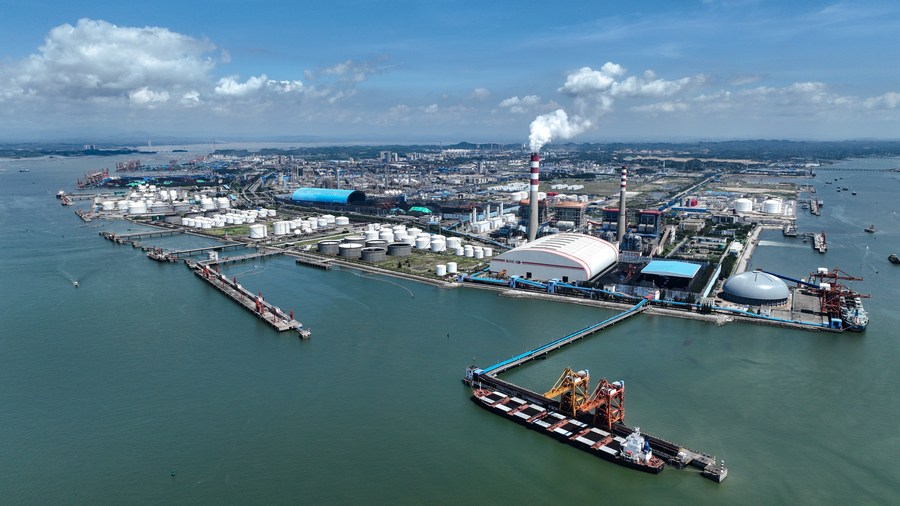China Economic Outlook 2023: A Global Propeller

China’s low inflation, low fiscal deficit, and low government debt make its macroeconomic environment more favorable than that of the U.S. and Europe, allowing China to adopt a wider variety of economic stimulus policies without worrying about inflation.
In December 2022, the Central Committee of the Communist Party of China (CPC) successively held two top-level meetings to review economic work in 2022, analyze the economic situation, and make arrangements for 2023. The two meetings delivered hope through clear and vigorous policy deployment which greatly boosted confidence in the Chinese market. With the world now engulfed in a pessimistic atmosphere due to crumbling economic growth, China’s persistently strong, resilient economy has been fostering certainty in a world full of uncertainties.
Rising risks of global recession
In 2022, multiple adverse factors including geopolitical conflicts, worsening inflation, monetary tightening, and COVID-19 resurgences continued brutalizing the world economy. Experiencing steep ups and downs, the global economy recorded a 3-percent growth rate during the year, much lower than the previous year’s 6 percent.
In 2023, the factors hindering global economic recovery remain, so as new challenges emerge, the world economy will likely stay sluggish. In terms of inflation, according to the International Monetary Fund (IMF), the global inflation level will decrease from 8.8 percent in 2022 to 6.5 percent in 2023, still far higher than the pre-pandemic period, which will further erode the purchasing power of consumers and impact the balance of payments of countries around the world. In terms of currency, although major economies including the United States and European countries raised interest rates dramatically in 2022, nagging inflation remained, forcing central banks to continue raising interest rates and tightening liquidity. As for the geopolitical situation, the outcome of the Russia-Ukraine conflict remains unclear, the Kosovo crisis broke out again, and the U.S. attempts to contain China in economics and security will likely continue, all of which prevent short-term solutions to the energy crisis, food shortage, and supply chain disruption. Furthermore, the debt problem, a “gray rhino” affecting the world economy, could ultimately hinder the speed of recovery. By October 2022, global debt had reached a record high of US$300 trillion, with total debts of developing countries swelling to nearly US$100 trillion. The World Bank warned that as global economy growth continues slowing with interest rates continuously rising, 60 percent of low-income countries face the possibility of a severe debt crisis.

The numbers have decimated confidence in the world economy, as evidenced by international organizations including the IMF and the Organization for Economic Cooperation and Development (OECD) joining multinational groups like Goldman Sachs and Morgan Stanley in downgrading forecasts for world economic growth in 2023 to 2 percent and even below 1 percent. More than half of the world’s economies including Britain, Germany, Sweden, Finland, and countries in Eastern Europe, Latin America, and Africa will likely teeter at the edge of zero growth or even dip into negative growth. America’s economy will also weaken. In 2022, a rebound in service consumption and substantial growth of exports helped the U.S. economy grew despite ongoing inflation and persistent interest rate hikes. But sluggish domestic demand, particularly negative growth in personal investment, has left the foundation for American economic recovery unsound.
As inflation and rising interest rates continue, American consumer and investor confidence has been decreasing. Global economic weakness, aggravated by economic recession in Europe, could end up hurting America’s exports, so optimism in U.S. economic prospects in 2023 has been rare. But due to a stable balance sheet of residents, the American economy can avoid a “hard landing,” with its growth rate possibly further slowing to 0.5 percent. The world economy is projected to show a “weak recession” trend in 2023 with continuous recession in the first half of the year, but a better outlook for the second half. The annual growth is predicted to reach about 2 percent. However, in a highly uncertain environment, whether the world economy will bottom out or stabilize remains a toss-up.
Resilient Asia
The outlook for the world economy has been grim, but some positive factors could prevent a return to a great recession like that of 2008 or 2020. Countries have adjusted pandemic prevention and control policies, which will help stimulate consumption and investment and boost market confidence. Some major economies will stop raising interest rates in the second half of 2023 or even cut them. This will ease the global financial strain and reduce the downward momentum of the world economy.
Although the risk of new variants of the coronavirus remains, the negative impact of the pandemic on the world economy is gradually receding, and the post-pandemic era is emerging with society returning to openness. More importantly, bucking the trend of negative growth, China and other Asian emerging markets will provide strong support for the steady recovery of the global economy and become a bright spot in the world.
The economies of India and ASEAN will maintain the momentum of rapid growth. In 2022, India’s economy grew fast, registering a 0.8-percent quarter-on-quarter (seasonally adjusted) growth in the third quarter and a 6.6-percent growth for the whole year, according to OECD data. In 2023, as dividends of the pandemic fade and borrowing costs rise, India’s economy will cool but still grow at a high rate of about 5.7 percent. ASEAN economies are also looking promising with the Asian Development Bank forecasting the bloc’s overall economic growth to maintain a medium-high growth rate of about 4.7 percent in 2023. Middle Eastern economies such as Saudi Arabia, which benefited from the global energy shortage, will also do well in 2023.

China in the driver’s seat
It is estimated that China will be the only major economy to manage a rebound in 2023. Last year, resurgences of COVID-19, continued interest rate hikes by the U.S. Federal Reserve, intensified constraints from the U.S., and downward adjustment of the real estate market resulted in strong headwinds for the Chinese economy. Its annual economic growth rate dropped significantly from 8.4 percent in the previous year (the latest revision) to 3 percent.
But after the CPC held its 20th National Congress, and especially after the country adjusted its COVID-19 response in November 2022, the Chinese economy began to grow at a faster pace. The decline of the negative impact of the pandemic on China’s economy, the evaporation of public fear, and the return to normal life will likely be followed by a rapid rebound and recovery of consumption including service consumption. The mismatch between China’s economic operations and financial cycle and those in the U.S. and Europe will also create dividends for China. The sharp contrast between China’s economic recovery and the downturn in the U.S. and Europe will help China attract more foreign investment. China’s low inflation, low fiscal deficit, and low government debt make its macroeconomic environment more favorable than that of the U.S. and Europe, allowing China to adopt a wider variety of economic stimulus policies without worrying about inflation. China’s advantages in economic scale, human capital, and new industrial strengths in fields like the digital economy, new infrastructure, new energy, and artificial intelligence compose a solid foundation for the transformation of economic momentum.
More importantly, China’s political and economic systems have endowed the Chinese government with strong mobilization and policy-making capabilities, which can help the country pool resources, make concerted efforts to cope with difficulties, and promote steady economic development. In December 2022, the Central Economic Work Conference solidified policy arrangements for China’s economic work in 2023, including actively expanding domestic demand, strengthening construction of the modern industrial system, enhancing the role of private enterprises, planning a new round of reform, promoting high-level opening up, preventing and defusing economic and financial risks, and boosting public confidence. With consideration of domestic and international situations, these policies cover both short- and long-term issues and balance development and security to create strong drivers for China’s economic growth.
Indeed, China’s economy is still facing many challenges. First, the uncertainty of the pandemic remains. Adjustments to pandemic prevention policies could exert pressure on the public health system and cause people to travel less, which might minimize the effects of reopening. Furthermore, various new coronavirus variants from around the world could enter China, triggering a new infection wave and affecting the recovery of the economy. Second, market confidence is still not stable enough. Confidence is key to economic rebound, but since 2020, the Chinese economy has performed worse than expected for consecutive years. The unemployment rate among young people is increasing, small and medium-sized enterprises still grapple with difficulties, and household disposable income is lower than expected, resulting in insufficient confidence among consumers and investors and inefficient policy transmission that hinders the effectiveness of various policies. Third, reviving the real estate industry has been difficult. For many years, real estate contributed more than one-fourth of China’s economic drive, but the peak has passed, heralding a new period of placid growth, hurting its driving effect on economic growth. And the decline of external demand and the accelerated aging of the population have become new constraints hindering China’s economic growth.
Considering all these factors together, China’s economic growth is expected to reach 5 percent to 6 percent in 2023 and serve as a major engine of the world economy by driving the growth of countries in its neighborhood, Africa, and Latin America. Recently, international banks including Goldman Sachs and Morgan Stanley raised the forecast for China’s economic growth in 2023 from around 4.5 percent to more than 5.2 percent, which demonstrates the international community’s growing confidence in the Chinese economy.
The author is a research fellow with the China Institutes of Contemporary International Relations and director of the Center for BRICS and G20 Studies.
 Facebook
Facebook
 Twitter
Twitter
 Linkedin
Linkedin
 Google +
Google +










